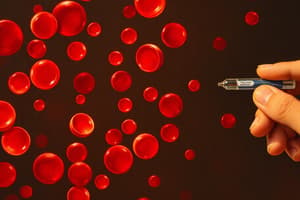Podcast
Questions and Answers
What is the main purpose of haematological indices?
What is the main purpose of haematological indices?
- To diagnose disease conditions such as anaemia and cancers (correct)
- To measure the severity of injuries
- To monitor platelet count only
- To provide information about white blood cell count
What are the two main groups of haematological indices?
What are the two main groups of haematological indices?
- Platelet indices and Haemoglobin indices
- Red blood cell indices and White blood cell indices
- Haemoglobin indices and Mean corpuscular indices
- Red blood cell indices and Platelet indices (correct)
Who introduced the concept of Red blood cell indices in 1929?
Who introduced the concept of Red blood cell indices in 1929?
- Wintrobe (correct)
- Ruth Takyi Perbi
- Mrs. Perbi
- MLS
What does the Mean corpuscular/cell volume (MCV) measure?
What does the Mean corpuscular/cell volume (MCV) measure?
What is the name of the index that measures the average amount of haemoglobin in a single red blood cell?
What is the name of the index that measures the average amount of haemoglobin in a single red blood cell?
What do abnormal values of Red blood cell indices indicate?
What do abnormal values of Red blood cell indices indicate?
How many types of Red blood cell indices are there?
How many types of Red blood cell indices are there?
What is the purpose of Red blood cell indices?
What is the purpose of Red blood cell indices?
What does the Mean Corpuscular Volume (MCV) indicate?
What does the Mean Corpuscular Volume (MCV) indicate?
What is the normal range for MCH?
What is the normal range for MCH?
What is the formula to calculate MCH?
What is the formula to calculate MCH?
What does a high MCHC indicate?
What does a high MCHC indicate?
What is the purpose of the Rule of Three?
What is the purpose of the Rule of Three?
What does Plateletcrit (PCT) measure?
What does Plateletcrit (PCT) measure?
What is the normal range for Plateletcrit (PCT)?
What is the normal range for Plateletcrit (PCT)?
What is the formula to calculate Plateletcrit (PCT)?
What is the formula to calculate Plateletcrit (PCT)?
What does a high MPV indicate?
What does a high MPV indicate?
What does a low MPV indicate?
What does a low MPV indicate?
Flashcards are hidden until you start studying
Study Notes
Introduction to Haematological Indices
- Haematological indices are part of the full blood count test report.
- They play a vital role in diagnosing disease conditions such as anaemia, cancers, etc.
- They are simple, inexpensive, and practical severity markers for disease conditions.
- They can be grouped into Red Blood Cell (RBC) indices and Platelet indices.
Red Blood Cell Indices
- RBC indices provide information about the haemoglobin content and size of red blood cells.
- Abnormal values indicate the presence of anaemia and its type.
- There are four types of RBC indices:
- Mean Corpuscular Volume (MCV) - measures the average size of red blood cells.
- Mean Corpuscular Haemoglobin (MCH) - measures the average amount of haemoglobin in a single red blood cell.
- Mean Corpuscular Haemoglobin Concentration (MCHC) - measures haemoglobin in red blood cells.
- Red Cell Distribution Width (RDW) - measures differences in the volume and size of red blood cells.
MCV
- MCV gives an indication of whether red blood cells are normocytes, microcytes, or macrocytes.
- Normal value: 80-100 fl (femtolitre).
MCH
- MCH gives an indication of whether red blood cells are normochromic, hypochromic, or hyperchromic.
- Normal value: 28-34 pg (picogram).
- MCH increases with B12 deficiency, folic acid deficiency, and reticulocytosis.
- MCH decreases with iron deficiency anaemia, thalassaemia, and anaemia of chronic disorder.
MCHC
- MCHC measures the average concentration of haemoglobin in a deciliter of erythrocytes.
- Normal value: 32-36 g/dl.
- MCHC increases with hypochromic red blood cells.
- MCHC decreases with hyperchromic red blood cells.
Rule of Three
- A formula to interpret the accuracy of RBC count, haematocrit, and haemoglobin values.
Platelet Indices
- Platelet indices are useful markers for the early diagnosis of thromboembolic diseases.
- They consist of:
- Plateletcrit (PCT) - measures total platelet mass.
- Platelet Distribution Width (PDW) - reflects variability in platelet sizes.
- Mean Platelet Volume (MPV) - measures the average size of platelets.
Plateletcrit (PCT)
- PCT is a measure of total platelet mass, occupying a percentage of blood volume.
- Normal value: 0.20 to 0.36%.
Mean Platelet Volume (MPV)
- MPV is a sign that the body is producing too many platelets.
- A high MPV indicates large platelets, associated with platelet activation.
- A low MPV indicates smaller platelets, associated with ineffective platelet formation in the bone marrow.
Platelet Distribution Width (PDW)
- PDW reflects variability in platelet sizes, associated with vascular disease or certain cancers.
Studying That Suits You
Use AI to generate personalized quizzes and flashcards to suit your learning preferences.




